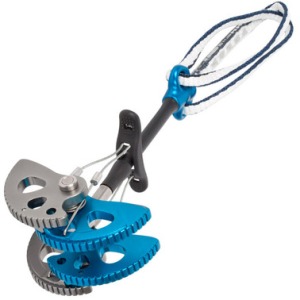Never tried via ferrata before? Here’s a quick round-up of some useful via ferrata resources.
Introduction To Via Ferrata in the Dolomites
Never tried via ferrata before? Here’s a quick round-up of some useful via ferrata resources.
Introduction To Via Ferrata in the Dolomites
 Camming devices are usually known as ‘cams’ or ‘camming units’. Hardly any climbers refer to this piece of equipment by its actual name, ‘spring loaded camming device‘. The name originates from the fact that the lobes of the device, when weighted, cam outwards, providing secure pieces of climbing protection. The quality of a camming device is determined by how effectively its cams are able to grab hold of the rock in different kinds of placements.
Camming devices are usually known as ‘cams’ or ‘camming units’. Hardly any climbers refer to this piece of equipment by its actual name, ‘spring loaded camming device‘. The name originates from the fact that the lobes of the device, when weighted, cam outwards, providing secure pieces of climbing protection. The quality of a camming device is determined by how effectively its cams are able to grab hold of the rock in different kinds of placements.
Not all camming devices are equal and moreover, some are simply more suited to specific climbing environments than others. As a general rule of thumb, the majority of rock climbers like to try their hand at everything and will aim to find a cam that can serve them well in a variety of scenarios, working just as well in the Red Rocks as it does in a High Sierra summit. The good news is that there are cams that really can ‘ do it all’, serving the climber well in all of their outdoor pursuits.
Climbing in pin scar areas
If you typically climb in places like Indian Creek, where the cracks are perfectly parallel, then almost any type of cam will do; however, ideally, cams with a large surface area – such as those from Wild Country– will work the best. When it comes to climbing on cliffs that have a lot of pin scars, offset or hybrid cams from a reputable brand are the most suitable, as two out of the four lobes of the device are smaller. All four lobes on this type of cam area also tightly packed together, so that the head width of the cam is compact.
It can be difficult to decide on the number of offset pieces you should carry, along with standard cam models. Normally, professional climbers will carry one offset and a couple of standard cams. However, if climbing a wall, two offsets and two standard cams are usually more suited. No offset cams will be needed if you intend to climb in desert terrain, which typically has cracks that are perfectly parallel.
Does ‘cam walking’ matter to you?
Cam walking is a term used to describe the movement of the climber’s lead rope being transferred to the cam, resulting in the device ‘walking’ or moving around. If the cam ends up walking in, then it may end up getting stuck, whilst if it walks out, it may end up being less secure. According to experts from Wild Country, there are three features that can have an effect on the likelihood of cam walking occurring; sling length, head width and stem flexibility. Camming devices with flexible stems, like the ones sold by Wild Country, are likely to remain in place. Conversely a narrow head, whilst useful for getting the device into shallow rock placements, is more prone to walking. Consequently, when shopping for a new device, each climber needs to consider the type of terrain they will be covering and how much cam walking really bothers them.

A selection of useful resources on the arduous nature of winter mountaineering that you may want to read before tackling the next climb.
|